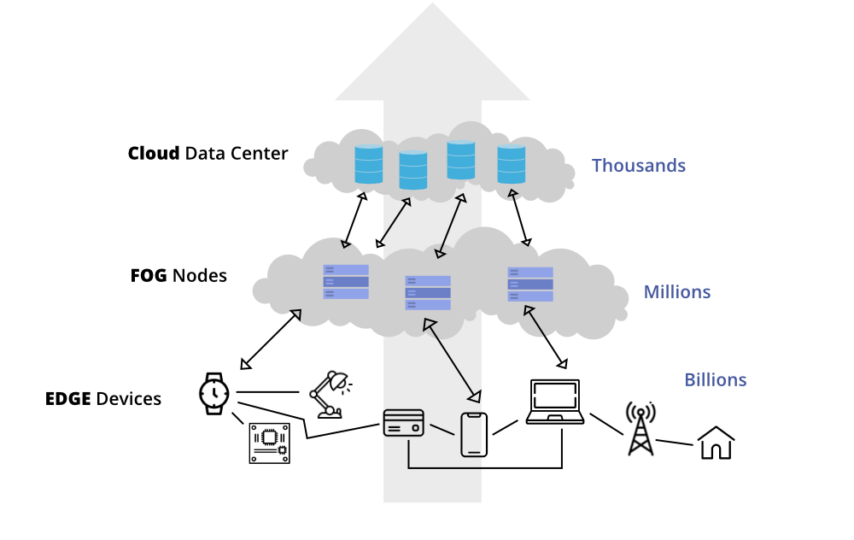Organizations are adopting cloud and edge computing models to meet the demand for better performance and faster speeds.
Digital transformation is happening worldwide, and speed, reliability, scale, and user experience are critical factors.
Therefore, making an informed decision about which model to implement is crucial for ensuring a business.
This article will help you understand the differences between edge computing and traditional computing. Furthermore, it will help you understand what’s best for your business.
What Is Cloud Computing?
Cloud computing is a revolutionary way of providing computing services via the Internet. It encompasses a wide range of services. This includes:
- Analytics.
- Development.
- Storage.
- Intelligence.
- Databases.
- Servers.
Moreover, these services offer individuals and businesses seamless digital transformation solutions. Business owners can integrate these solutions into their custom digital marketing strategies, email storage, and streaming services.
Therefore, cloud services can typically help you to host at a central data center, managed expertly by a service provider.
What Is Edge Computing?
Edge computing is an innovative IT architecture that facilitates computing operations in close proximity to the source of data.
This cutting-edge technology leverages physical tools to enable faster data processing and reduce latency. These tools include the following:
- Edge nodes.
- IoT devices.
- Cameras.
- Sensors.
Edge computing is a method of processing data. It reduces the travel distance for processing in the cloud.
This means that it processes data in real time and increases bandwidth. Moreover, it movers computing closer to the source of the data. Therefore, edge computing helps to minimize the need for data to travel long distances, which results in faster processing times.
This advanced IT architecture is widely used in businesses to meet their computing needs quickly and efficiently.
Characteristics Of Cloud Computing
Cloud computing leverages remote data centers and servers for processing, analyzing, and transferring large-scale data.
Additionally, cloud services can offer significant storage capacity.
This deployment type provides virtualized computational resources on demand, making the infrastructure more scalable and elastic.
Infrastructure as a Service (IaaS)
Infrastructure as a Service (IaaS) is a cloud computing model where companies can lease processing resources. These resources include servers and storage resources from a third-party provider, such as data centers.
Moreover, IaaS allows companies to access and use these resources on demand. Therefore, businesses don’t have to invest in and maintain their physical infrastructure.
Platform as a Service (PaaS)
Platform as a Service (PaaS) allows developers to focus on writing, deploying, and managing applications. With cloud computing, businesses don’t have to worry about underlying resources like software and hardware.
Therefore, it simplifies the process of building and deploying applications. Moreover, it does all this without the complexities and costs associated with infrastructure management.
Software as a Service (SaaS)
Software as a Service (SaaS) is a cloud-based delivery model that provides access to various management tools and programs.
SaaS offers a subscription-based service. With cloud computing, users can access these tools and programs without paying or installing software on their own computers.
Characteristics Of Edge Computing
Companies continue to seek ways to process data more quickly and efficiently. Therefore, many are transitioning from traditional infrastructure to edge computing setups using SPTel’s edge cloud.
This shift has become increasingly popular due to the benefits it offers.
Here are the benefits of using edge computing:
Reduced Latency
Latency refers to the time it takes for a particular service to respond to a user’s request. The traditional centralized approach involves transmitting data to the cloud.
It helps process and analyze data, resulting in significant delays.
However, edge computing offers a viable solution by bringing processing and analytics closer to the source. This enables data to be stored and processed on the device.
Therefore, edge computing eliminates the need for cloud transfer. This advantage leads to faster feedback and real-time responses, providing a superior user experience.
Real-Time Analytics
Edge computing is a cutting-edge technology that combines AI with high-performance computing. It allows real-time analytics to be performed on devices. Therefore, it eliminates the need to transmit data to the cloud, reducing latency and providing faster feedback.
Additionally, it helps IoT devices, such as Smart Video Doorbells and Smart Home systems.
Edge solutions make machine learning possible by providing real-time insights and predictions.
Therefore, this technology is transforming the way data is processed and analyzed.
Moreover, with faster and more efficient data-driven decisions, edge computing empowers businesses to achieve their goals faster.
Enhanced Data Security
Edge computing stores sensitive data locally on user devices. Therefore, it increases security and reduces the risk of data hacking.
It also allows for local processing and analysis of data. Therefore, you can have a secure environment for sensitive information.
Cost-Effective
Edge computing is a modern approach that brings significant cost benefits compared to traditional cloud-based solutions.
This is because edge computing reduces latency and minimizes bandwidth and network resource usage. Moreover, it eliminates the need for cloud storage.
Which Option Is Better?
Edge computing is a decentralized approach to data security that enables collaboration across platforms and providers.
Therefore, it reduces vendor lock-in risks. Edge computing also allows data processing across multiple nodes and devices, improving security and privacy.
However, pricing methods differ between cloud and edge computing, with cloud models contracting a service plan with maximum capacity.








